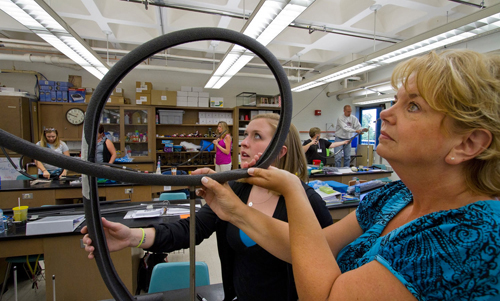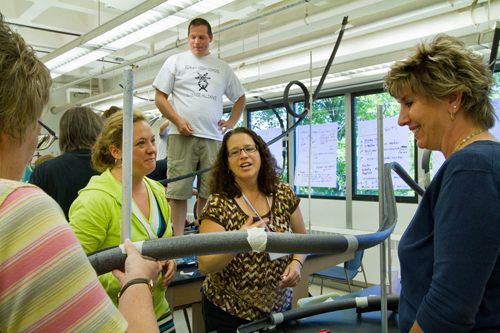Posted 4:05 p.m. Thursday, June 28, 2012

 [/caption]Laughter, concentration and collaboration were just a few byproducts of a science experiment in Cowley Hall Tuesday.
In the lab, K-12 teachers were working alongside UW-La Crosse physicists to understand the force, motion, velocity and energy at play as they constructed model roller coasters.
The activity was fun and a good learning experience teachers can later apply in science classes. It was also the beginning of important relationship among K-12 teachers and UW-L scientists as they prepare students to meet future education standards.
The UW-L Department of Physics received a $287,000 [caption id="attachment_13084" align="alignright" width="500" caption="State Sen. Jennifer Shilling, far right, visited the physics lab and praised teachers and UW-L faculty for their collaboration. “You are fostering an appetite for education,” she noted. She also joked about her poor academic record in the sciences while a student at UW-La Crosse. “If some of my teachers had participated in this — I may have stuck with science a little longer,” she said with a grin."]
[/caption]Laughter, concentration and collaboration were just a few byproducts of a science experiment in Cowley Hall Tuesday.
In the lab, K-12 teachers were working alongside UW-La Crosse physicists to understand the force, motion, velocity and energy at play as they constructed model roller coasters.
The activity was fun and a good learning experience teachers can later apply in science classes. It was also the beginning of important relationship among K-12 teachers and UW-L scientists as they prepare students to meet future education standards.
The UW-L Department of Physics received a $287,000 [caption id="attachment_13084" align="alignright" width="500" caption="State Sen. Jennifer Shilling, far right, visited the physics lab and praised teachers and UW-L faculty for their collaboration. “You are fostering an appetite for education,” she noted. She also joked about her poor academic record in the sciences while a student at UW-La Crosse. “If some of my teachers had participated in this — I may have stuck with science a little longer,” she said with a grin."] [/caption]grant from the Wisconsin Department of Public Instruction in January to offer the physical science workshops through August 2013 for teachers in the La Crosse, Tomah and Onalaska school districts. Partners in the grant include UW-L, the three school districts, CESA #4 and Redman & Associates. The two-year grant is committed to collaboration and preparation of teachers to meet new Next Generation Science Standards, likely to be released in spring 2013. The standards aim to get science teachers on the same page in preparing America’s students with a strong foundation in science for the 21st century. They move away from the ‘mile-wide, inch thick’ science curriculum mentality toward a more in-depth look at concepts, which are revisited and expanded upon in later grades, says Jerry Redman, of Redman & Associates LLC., who helped write the grant.
“We’re in uncharted waters and these are our guides,” says Geri Wettstein, a kindergarten teacher at Hamilton Elementary School pointing to UW-L faculty. “They have really made themselves available.”
Wettstein adds that teachers have been excited about taking the information and example labs back to classrooms.
“A number of teachers don’t feel comfortable teaching physical science,” says Gubbi Sudhakaran, chair of the physics department. “We want to make them comfortable with these topics and teach them new activities to use in their classes.”
But the benefit is not only for K-12 teachers. UW-L physicists see many advantages from the collaboration as well, says Jennifer Docktor, UW-L assistant professor of physics. For instance, Docktor can better prepare future teacher candidates at UW-L by working with K-12 teachers and understanding the standards they must meet. Not only that, when teachers become excited about science, it may spark more interest in science among students, she says. That is important at a time when more college graduates are needed in Science, Technology, Engineering and Mathematics fields. Jobs in STEM fields have grown at a much faster rate than non-STEM jobs over the past 10 years. That trend is expected to continue into the foreseeable future, according to a U.S. Department of Commerce report.
Docktor even sees the benefit in her future physics classrooms.
“If we have higher quality education in K-12, students will be coming to college better prepared for their science classes,” she says.
Those students in college classes are then better prepared to enter the workforce as physics teachers and in other science fields, says Sudhakaran.
“We know the best place to start (with this preparation) is elementary and middle school,” he notes.
[/caption]grant from the Wisconsin Department of Public Instruction in January to offer the physical science workshops through August 2013 for teachers in the La Crosse, Tomah and Onalaska school districts. Partners in the grant include UW-L, the three school districts, CESA #4 and Redman & Associates. The two-year grant is committed to collaboration and preparation of teachers to meet new Next Generation Science Standards, likely to be released in spring 2013. The standards aim to get science teachers on the same page in preparing America’s students with a strong foundation in science for the 21st century. They move away from the ‘mile-wide, inch thick’ science curriculum mentality toward a more in-depth look at concepts, which are revisited and expanded upon in later grades, says Jerry Redman, of Redman & Associates LLC., who helped write the grant.
“We’re in uncharted waters and these are our guides,” says Geri Wettstein, a kindergarten teacher at Hamilton Elementary School pointing to UW-L faculty. “They have really made themselves available.”
Wettstein adds that teachers have been excited about taking the information and example labs back to classrooms.
“A number of teachers don’t feel comfortable teaching physical science,” says Gubbi Sudhakaran, chair of the physics department. “We want to make them comfortable with these topics and teach them new activities to use in their classes.”
But the benefit is not only for K-12 teachers. UW-L physicists see many advantages from the collaboration as well, says Jennifer Docktor, UW-L assistant professor of physics. For instance, Docktor can better prepare future teacher candidates at UW-L by working with K-12 teachers and understanding the standards they must meet. Not only that, when teachers become excited about science, it may spark more interest in science among students, she says. That is important at a time when more college graduates are needed in Science, Technology, Engineering and Mathematics fields. Jobs in STEM fields have grown at a much faster rate than non-STEM jobs over the past 10 years. That trend is expected to continue into the foreseeable future, according to a U.S. Department of Commerce report.
Docktor even sees the benefit in her future physics classrooms.
“If we have higher quality education in K-12, students will be coming to college better prepared for their science classes,” she says.
Those students in college classes are then better prepared to enter the workforce as physics teachers and in other science fields, says Sudhakaran.
“We know the best place to start (with this preparation) is elementary and middle school,” he notes.
